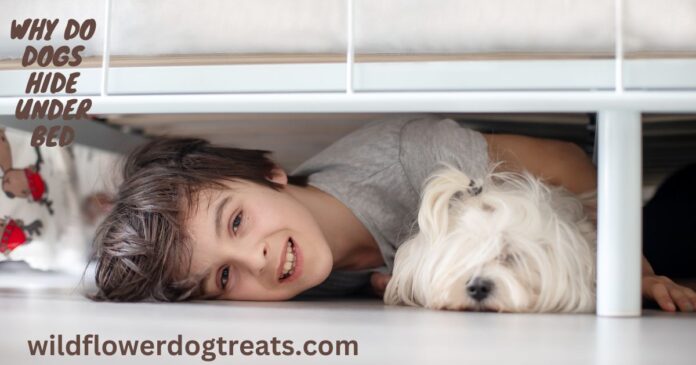Dogs hide under the bed due to fear or seeking comfort, security from perceived threat, or as their safe sanctuary. Many dog owners wonder why their pets often hide under the bed.
Understanding this behavior is essential for pet owners to provide necessary care and support. Dogs might hide under the bed when feeling anxious, scared, or seeking comfort and security. This behavior can be triggered by loud noises, unfamiliar visitors, or changes in their environment.
Additionally, dogs often perceive the space under the bed as their safe sanctuary where they feel protected and secure. Recognizing these signs and providing support is crucial for responsible pet owners to ensure their furry friends feel safe and secure in their surroundings. Understanding the reasons behind this behavior can help strengthen the bond between dogs and their owners.
Factors Influencing Canine Behavior
Factors influencing canine behavior play a crucial role in understanding our furry friends’ actions and reactions. When it comes to why dogs hide under the bed, it’s essential to consider various aspects that can lead to this behavior. From genetics to environment and socialization, each factor has a significant impact on a dog’s tendency to seek shelter beneath the bed.
Genetics
Genetics are an influential factor in a dog’s behavior, including their instinct to seek refuge under the bed. Some breeds have inherited traits that make them more prone to seeking secluded spots for safety and security. This behavior can be traced back to their ancestors, such as wolves, who sought shelter in dens for protection from predators. The genetic predisposition of certain breeds can make them more inclined to find comfort and security in confined spaces like under the bed.
Environment
Environment plays a crucial role in shaping a dog’s behavior, including their tendency to hide under the bed. Dogs may seek refuge under the bed in response to environmental stressors, such as loud noises, unfamiliar visitors, or changes in their surroundings. A tumultuous or chaotic environment can prompt a dog to seek solace in a quiet, enclosed space, making the area under the bed an appealing choice for them to retreat to.
Socialization
Socialization during a dog’s formative years can significantly impact their behavior, including their inclination to hide under the bed. A lack of proper socialization during puppyhood can lead to anxiety and fearfulness in adult dogs, causing them to seek out hiding spots as a coping mechanism. Additionally, negative experiences or traumas during interactions with humans or other animals can contribute to a dog’s propensity to seek shelter under the bed when feeling stressed or threatened.
Root Causes And Triggers
Dogs are known for their instinctive behaviors, and one common behavior many dog owners observe is their tendency to hide under the bed. While it may seem odd and even a bit humorous, this behavior can signal underlying causes related to fear, anxiety, seeking shelter, and security. Understanding these root causes and triggers can help pet owners better address their dog’s needs and provide appropriate support.
Fear And Anxiety
Fear and anxiety can significantly contribute to a dog’s tendency to hide under the bed. Loud noises, unfamiliar visitors, or sudden changes in the environment can trigger feelings of insecurity and unease in dogs.
Seeking Shelter And Security
Seeking shelter and security is another common reason why dogs gravitate towards hiding under the bed. Just like their wild ancestors sought shelter in dens or burrows, domestic dogs seek similar safe zones to escape from perceived threats or simply find a comfortable, secure spot to rest undisturbed.
Identifying Stress And Anxiety In Pets
Pets, particularly dogs, may hide under the bed as a sign of stress or anxiety. This behavior could be triggered by loud noises, changes in the environment, or feeling unsafe. It’s important to observe your pet’s actions and provide a calming environment to alleviate their distress.
Hiding Behaviors
Dogs hiding under the bed is a common behavior that can indicate stress or anxiety. When a dog feels overwhelmed, they may seek out a small, enclosed space like under the bed to feel safe and secure. It’s important to observe your dog’s hiding behaviors and take note if it becomes excessive or out of the ordinary. Frequent hiding may be a sign of underlying stress that needs to be addressed.
Trembling Or Shaking
In addition to hiding under the bed, dogs may exhibit trembling or shaking when they are stressed or anxious. This physical reaction is a clear indication that your dog is experiencing emotional distress. Keep an eye out for these signs and consider seeking assistance from a veterinarian or animal behaviorist if you notice these behaviors persisting.
Excessive Panting
Another indication of stress in dogs is excessive panting. If your dog is not overly active and yet panting heavily, it could be a sign that they are feeling anxious or stressed. Pay attention to any changes in your dog’s panting patterns and consult a professional if you have concerns about their emotional well-being. Understanding these subtle cues can help you provide the appropriate support for your furry friend. “`
Creating A Safe And Comfortable Environment
Dogs may often choose to hide under the bed, seeking comfort and security. As caring pet owners, it’s essential to understand the reasons behind this behavior and create a safe and comfortable environment to address their needs.
Providing A Cozy Den
To help your dog feel safe and secure, consider providing a cozy den-like space within your home. This could be a comfortable dog bed with soft blankets and pillows, placed in a quiet and secluded area. Ensuring this designated space remains consistent will give your dog a sense of security and a place they can retreat to when feeling anxious or overwhelmed.
Encouraging Positive Associations
Utilize positive reinforcement techniques to create a positive association with the designated den space. This can be achieved by offering treats, toys, or gentle praise when your dog voluntarily enters and stays in their den. By doing so, your dog will view their den as a safe and comfortable place, reducing the likelihood of seeking refuge under the bed.
Seeking Professional Guidance
If your dog’s behavior of hiding under the bed persists and causes distress, it’s important to seek professional guidance from a certified dog behaviorist. A professional can assess the underlying reasons for your dog’s behavior and provide tailored strategies to create a safe and comfortable environment, fostering a sense of security and overall wellbeing.
Frequently Asked Questions Of Why Do Dogs Hide Under The Bed
Why Do Dogs Hide Under The Bed?
Dogs hide under the bed because it provides them with a sense of security and comfort. It’s a natural instinct for them to seek out small, enclosed spaces when feeling anxious or tired. This behavior also stems from their wild ancestors who used such spaces for protection.
Is It Normal For Dogs To Hide Under The Bed?
Yes, it’s normal for dogs to seek shelter under the bed. It’s a coping mechanism that helps them feel safe and secure, especially during thunderstorms or when they’re not feeling well. However, it’s important to monitor their behavior to ensure it’s not a sign of underlying anxiety or health issues.
How Can I Encourage My Dog To Come Out From Under The Bed?
Start by creating a positive association with the area outside the bed. Use treats, toys, or gentle encouragement to entice your dog out. Additionally, provide them with a comfortable and safe alternative, such as a cozy dog bed or crate, to help them feel secure outside of the bed.
What Should I Do If My Dog Hides Under The Bed Excessively?
Excessive hiding under the bed could be a sign of an underlying issue, such as anxiety, fear, or an undiagnosed health problem. It’s essential to observe their behavior, consult a veterinarian to rule out any health concerns, and consider behavioral training or therapy to address any underlying anxiety.
Conclusion
So, if your dog is hiding under the bed, remember it could be due to fear or anxiety. Providing a safe and secure environment, along with positive reinforcement, can help alleviate this behavior. Understanding your dog’s needs and providing them with comfort and support is crucial for their well-being.
With patience and love, you can help your furry friend feel safe and secure in their home.




